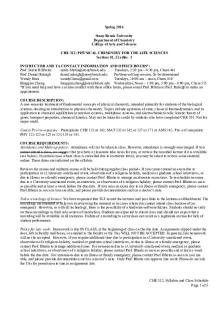5.-Problem-Solving-1 PDF PDF

| Title | 5.-Problem-Solving-1 PDF |
|---|---|
| Author | Richelle Ann Evangelista |
| Course | Mathematics in the Modern World |
| Institution | Our Lady of Fatima University |
| Pages | 21 |
| File Size | 1.7 MB |
| File Type | |
| Total Downloads | 306 |
| Total Views | 522 |
Summary
Warning: TT: undefined function: 32MATHEMATICSModern Worldin theJanina C. SerceniaCAS FacultyChapter I.The Nature of Mathematics Patterns and Numbers in Nature Fibonacci Sequence and the Golden RatioTypes of Pattern in Nature FRACTALS SPIRALS CHAOS SYMMETRY FRACTALSFractals are never-ending patterns...
Description
MATHEMATICS in the
Modern World
Janina C. Sercenia CAS Faculty
Chapter I.
The Nature of Mathematics • Patter ern ns an and d Num umb bers in Na Natu tu turre • Fib Fibon on onaacc ccii Seq Sequ uence an and d th the e Go Gold ld lden en Ra Rattio
A. Patter ns and Numbers in Nature • • • • • • •
What is Mathematics? Where is Mathematics? What is Mathematics for? What is Mathematics about? How is Mathematics done? Who uses Mathematics? Why is Mathematics Important to know/
Types of Patter n in Nature • • • •
FRACTALS SPIRALS CHAOS SYMMETRY
FRACTALS Fractals are never-ending patterns that are self-similar across different scales. It Involve symmetry of magnification (Dilation) - Its a shape that you could zoom in on a part of it in an infinite number of times and it would look the same.
FRACTALS
PROPERTIES • Self Similarity- appear the same under magnification. • Fractional Dimension • Formation of Iteration- form by a repeating process.
FRACTALS Applications
SPIRALS Spirals are curved patterns made by series of circular shapes revolving around central point.
SPIRALS
Applications/examples
CHAOS Chaos or chaotic pattern are simple patterns created from complicated underlying behavior. It used to described a kind of order which lacks predictability.
CHAOS
Applications/examples
SYMMETRY Symmetry is the exact correspondence of form and constituent configuration on the opposite sides of dividing line or plane or about a center or an axis. In Mathematics, an object are said to have symmetry when it remains unchanged after transformations such as rotation and scaling are applied to it.
SYMMETRY Different types of SYMMETRY A. Reflection Symmetry -Also called as mirror symmetry, line symmetry or bilateral symmetry. - It is made with a line going through an object which divides it into two pieces which are mirror images of each other.
Reflection Symmetr y
Applications/examples
SYMMETRY Different types of SYMMETRY B. Rotational Symmetry Also called as radial symmetry -It is exhibit by objects when their similar parts are regularly arranged around a central axis and the pattern looks the same after a certain amount of rotation
Rotational Symmetr y Applications/examples
SYMMETRY Different types of SYMMETRY B. Translational Symmetry It is exhibit by objects which do not change its size and shape even if it moves to another location. (Note: the movement does not involve with reflection or rotation.)
Self Assessment Question: Identify whether the following is a Fractals, Spirals, chaos, or symmetry.
1.
2.
3.
Self Assessment Question: Identify whether the following is a Fractals, Spirals, chaos, or symmetry.
4
5.
6.
Self Assessment Question: Identify whether the following is a Fractals, Spirals, chaos, or symmetry.
7.
8.
9.
Problem Set 1.A Identify whether the following is a Fractals, Spirals, chaos, or symmetry.
7.
8.
9....
Similar Free PDFs

- 9 Pages

Common Good PDF - pdf
- 7 Pages

- 2 Pages

- 43 Pages

- 47 Pages

- 5 Pages

- 130 Pages

- 16 Pages

Pdf Daniel - pdf
- 223 Pages

Keselamatan_Maritim_2.pdf
- 147 Pages

arens_auditing_14ce_ism_c18.pdf
- 25 Pages

Pdfcoffee - Pdf
- 39 Pages

Τσάμηδες PDF
- 8 Pages

Fundoscopia PDF
- 2 Pages
Popular Institutions
- Tinajero National High School - Annex
- Politeknik Caltex Riau
- Yokohama City University
- SGT University
- University of Al-Qadisiyah
- Divine Word College of Vigan
- Techniek College Rotterdam
- Universidade de Santiago
- Universiti Teknologi MARA Cawangan Johor Kampus Pasir Gudang
- Poltekkes Kemenkes Yogyakarta
- Baguio City National High School
- Colegio san marcos
- preparatoria uno
- Centro de Bachillerato Tecnológico Industrial y de Servicios No. 107
- Dalian Maritime University
- Quang Trung Secondary School
- Colegio Tecnológico en Informática
- Corporación Regional de Educación Superior
- Grupo CEDVA
- Dar Al Uloom University
- Centro de Estudios Preuniversitarios de la Universidad Nacional de Ingeniería
- 上智大学
- Aakash International School, Nuna Majara
- San Felipe Neri Catholic School
- Kang Chiao International School - New Taipei City
- Misamis Occidental National High School
- Institución Educativa Escuela Normal Juan Ladrilleros
- Kolehiyo ng Pantukan
- Batanes State College
- Instituto Continental
- Sekolah Menengah Kejuruan Kesehatan Kaltara (Tarakan)
- Colegio de La Inmaculada Concepcion - Cebu

![[PDF] Cours complet marketing en PDF Télécharger PDF](https://pdfedu.com/img/crop/172x258/gwrwp9kme218.jpg)